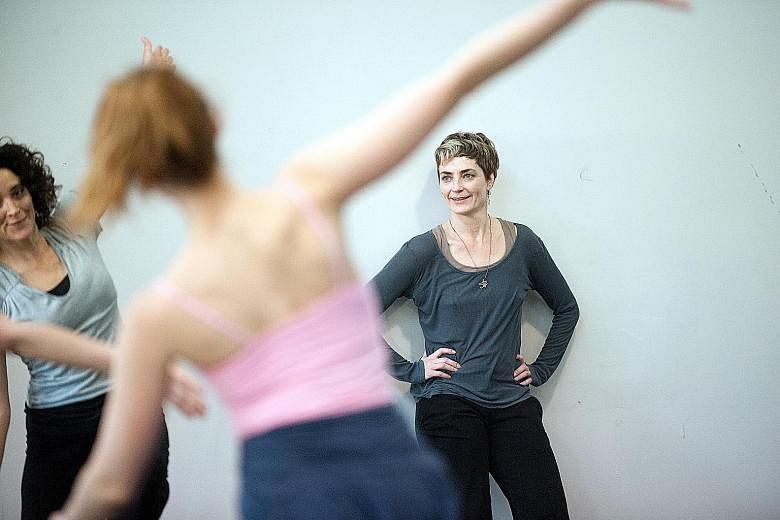The first time Dutch choreographer and dancer Anouk van Dijk, now a toned, long-limbed 50, saw a "real dancer", it moved her to tears.
She was 15 then, but can recall the experience with piercing clarity: "I didn't know a person could fill the room with so much energy. That day was a turning point for me."
Now, van Dijk is the artistic director of Chunky Move, one of Australia's leading contemporary dance groups, and the inventor of the Countertechnique system of movement. In this system, dancers give counterdirections to each movement, instead of relying on the pelvis as central axis. For example, when a hand moves forward, the rib cage should go backwards, and when the head goes upward, a foot should go down.
She will be in Singapore for the first time with two of her Chunky Move dancers, who will perform gentle is the power at the M1 Contact Contemporary Dance Festival's International Artist Showcase. The triple bill show also features Spanish choreographer Iratxe Ansa and Korea's R.se Dance Company.
1. You have been on both ends of the stage as a dancer and as a choreographer. Tell us more about your journey and what you enjoy and find challenging in each role.
-
BOOK IT/ M1 CONTACT CONTEMPORARY DANCE FESTIVAL 2015: INTERNATIONAL ARTIST SHOWCASE
WHERE: Esplanade Theatre Studio
WHEN: Saturday, 3 and 8pm
ADMISSION: $36 from Sistic (excludes booking fee; go to www.sistic.com.sg or call 6348-5555)
At the start of my career, I spent 10 years as a lead soloist for Rotterdam Dance Company and Amanda Miller's Pretty Ugly Dance Company, but was always attracted to the idea of creating performances.
Actually, the idea of becoming a choreographer began before the idea of being a dancer. But to become a choreographer, I knew I had to first learn how to be an interpreter.
After dancing as a soloist for a few years, I started choreographing works and then dedicated myself to my own dance company, anoukvandijk dc.
Performing, for me, is like an intimate date with a stranger. In the moment of performing, we meet together in a room and share time, focus and the topics the performance addresses.
There is no return. Only that moment counts, and the joy and terror of performing is that you are never in control of the outcome. This thrill of insecurity is the challenge and creates a strong ritual around performing.
At the same time, it is very simple: humans sharing a moment in time together. Now when I watch my dancers dance, I undergo the same thrill and experience the moment as intensely as they do. So there is not much difference between the two for me.
2. When the dancers are on stage, what are you up to? What are you feeling at the time?
I'm in the audience, experiencing the performance from the public's point of view. I want to feel what the audience feels and feel the response.
Of course, I still feel slightly nervous at the beginning of each performance, as each audience will respond differently. Each night, I see the show again with new eyes as each audience is different.
3. How did you come up with Countertechnique?
Creating my own technique was not on a whim but was borne out of necessity of coherence, and being proactive in my approach to dancing and taking care of my body.
I actually spent years analysing, researching, teaching and practising Countertechnique before I gave it a theoretical framework.
It is a movement system that helps dancers think about the dancing body - focusing on the process of incorporating information into action... It teaches you how to work with your body in the most efficient and safe manner.
4. What has your transition from the European dance scene to Australia been like?
When I came to Australia and started working with Australian dancers in 2012, we began to talk in rehearsals about art, society and the meaning of movement.
What became apparent was that despite our different backgrounds and cultures, we shared many of the same ideals, concerns and challenges. Our discussions revealed a group of individuals with clear opinions on the current state of their wider community and country.
The first line in my notebook for my first work in Australia reads: "We are living in a very passionate world where people take a lot of risks."
I have also discovered incredibly talented Australian performers with a unique and unstoppable energy. This roller-coaster into unknown territory has been really inspiring so far and I am looking forward to all the new plans we are developing with Chunky Move for the coming years.
5. What inspires you in your choreography work?
I'm interested in any work that seeks to provide an insight into all facets of the human experience and individuality in a world that is in constant change. In one of my recent works, Complexity Of Belonging (2014), that I created with German playwright Falk Richter, I explore the questions of identity and belonging in a contemporary and globalised world.
I'm increasingly interested in site-specific work and have created two in Melbourne: An Act Of Now (2012), in an outdoor music venue, and Depth Of Field (2015), in a vast and dusty urban landscape near our Chunky Move studios.
6. What do you do to unwind after a performance?
Drink a nice single malt whiskey and enjoy some good food!


